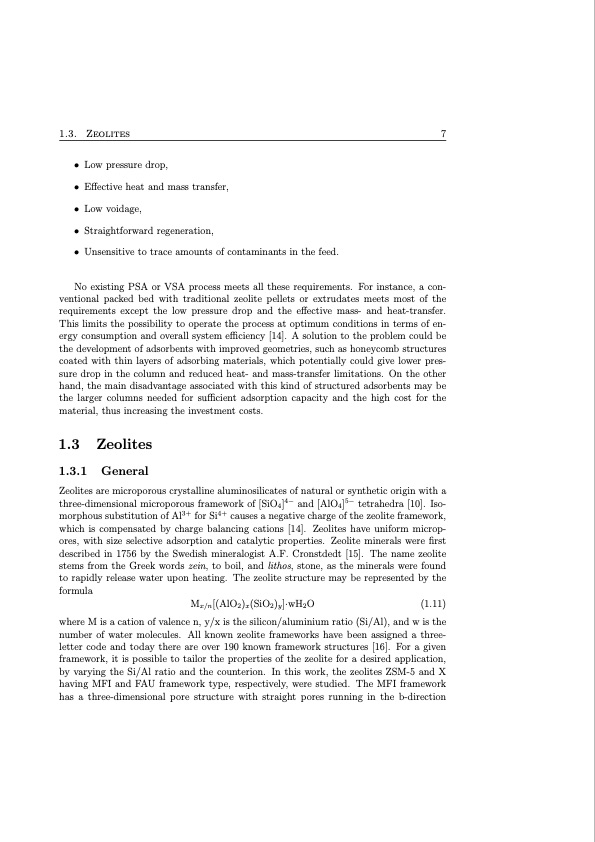
PDF Publication Title:
Text from PDF Page: 023
1.3. Zeolites 7 • Low pressure drop, • Effective heat and mass transfer, • Low voidage, • Straightforward regeneration, • Unsensitive to trace amounts of contaminants in the feed. No existing PSA or VSA process meets all these requirements. For instance, a con- ventional packed bed with traditional zeolite pellets or extrudates meets most of the requirements except the low pressure drop and the effective mass- and heat-transfer. This limits the possibility to operate the process at optimum conditions in terms of en- ergy consumption and overall system efficiency [14]. A solution to the problem could be the development of adsorbents with improved geometries, such as honeycomb structures coated with thin layers of adsorbing materials, which potentially could give lower pres- sure drop in the column and reduced heat- and mass-transfer limitations. On the other hand, the main disadvantage associated with this kind of structured adsorbents may be the larger columns needed for sufficient adsorption capacity and the high cost for the material, thus increasing the investment costs. 1.3 Zeolites 1.3.1 General Zeolites are microporous crystalline aluminosilicates of natural or synthetic origin with a three-dimensional microporous framework of [SiO4]4− and [AlO4]5− tetrahedra [10]. Iso- morphous substitution of Al3+ for Si4+ causes a negative charge of the zeolite framework, which is compensated by charge balancing cations [14]. Zeolites have uniform microp- ores, with size selective adsorption and catalytic properties. Zeolite minerals were first described in 1756 by the Swedish mineralogist A.F. Cronstdedt [15]. The name zeolite stems from the Greek words zein, to boil, and lithos, stone, as the minerals were found to rapidly release water upon heating. The zeolite structure may be represented by the formula Mx/n [(AlO2 )x (SiO2 )y ]·wH2 O (1.11) where M is a cation of valence n, y/x is the silicon/aluminium ratio (Si/Al), and w is the number of water molecules. All known zeolite frameworks have been assigned a three- letter code and today there are over 190 known framework structures [16]. For a given framework, it is possible to tailor the properties of the zeolite for a desired application, by varying the Si/Al ratio and the counterion. In this work, the zeolites ZSM-5 and X having MFI and FAU framework type, respectively, were studied. The MFI framework has a three-dimensional pore structure with straight pores running in the b-directionPDF Image | Structured Zeolite Adsorbents for PSA Applications

PDF Search Title:
Structured Zeolite Adsorbents for PSA ApplicationsOriginal File Name Searched:
structured-zeolites.pdfDIY PDF Search: Google It | Yahoo | Bing
CO2 Organic Rankine Cycle Experimenter Platform The supercritical CO2 phase change system is both a heat pump and organic rankine cycle which can be used for those purposes and as a supercritical extractor for advanced subcritical and supercritical extraction technology. Uses include producing nanoparticles, precious metal CO2 extraction, lithium battery recycling, and other applications... More Info
Heat Pumps CO2 ORC Heat Pump System Platform More Info
| CONTACT TEL: 608-238-6001 Email: greg@infinityturbine.com | RSS | AMP |